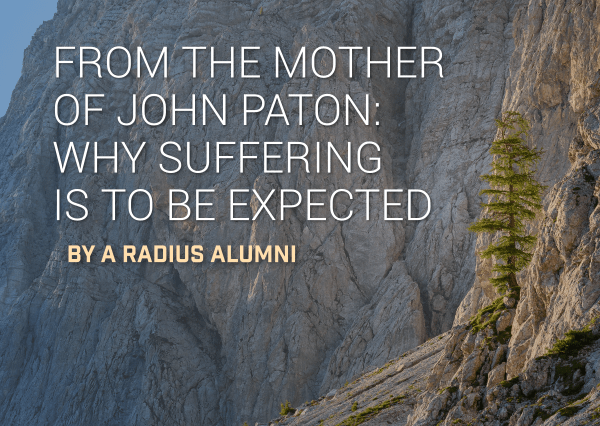From the Mother of John Paton: Why Suffering is to be Expected
Yes, you read that right, John Paton. You’re probably thinking, hasn’t he been dead for over one hundred years? He has, but I am the mother of a one-year-old John Paton. When deciding on our youngest son’s name, we had already decided to move forward with our conviction from scripture of taking the gospel to an unreached language group. We decided on the name, John Paton, not in hopes that he would become an extraordinary missionary himself one day, but that in our times of suffering his name would serve as a reminder of the saints that had gone before us. A reminder of John G. Paton’s life and how the Kingdom of God advanced in his times of suffering.
Scripture tells us in James 1:2 “Count it all joy my brothers, when you face trials of various kinds.” James doesn’t say if he says when we face trials of various kinds. Suffering is certain in the Christian life, not just missionary life. We are reminded that we are separated from God, and there will be many trials on this side of heaven. I am encouraged that so many saints of old like John Bunyan, Samuel Rutherford, and Thomas Watson saw the Christian life not through rose-colored glasses, but for what it is. A long, often painful, road that is only made possible if we are sustained on our journey by the grace of our God.
Not only will there be trials, but because we have Christ, we can count those trials as joy. We know our God is sovereign and this is a part of His plan for making us more like Christ and reconciling the world to himself. James says trials will come in various kinds, meaning they may look like giant obstacles or 1,000 papercuts adding up to a hard life. In either of the two or anything in between there is purpose and plan. If we read further, verses three and four are reminders of the purpose. “For you know that the testing of your faith produces steadfastness. And let steadfastness have its full effect that you may be perfect and complete, lacking in nothing.” The testing of our faith produces steadfastness. Steadfastness makes us more like Christ, he is the only one perfect and complete, and through the testing of our faith and trials of many kinds we will become more and more like Christ, only by God’s grace. We believers can rest assured that suffering is a normative part of the Christian life, and it is God’s sovereign will that we can find our joy even in times of suffering.
The sweetness though of suffering is in the way the Lord uses it to further his purposes. God uses the suffering of believers to advance his name. In the book of Acts, we see the early church multiplying as the church is persecuted. In Philippians 3:10, Paul says, “That I may share his sufferings, becoming like him in his death.” Again, in Romans 8:17, Paul says, “And if children, then heirs – heirs of God and fellow heirs with Christ – provided we suffer with him in order that we may also be glorified with him.” What a hope we have in Christ, that as we share in His sufferings, we will also be glorified with him one day in eternity. We, as believers, can know that as we suffer here on Earth we can cling to the truth God left us in His word. We, as believers, can know that as we suffer we can remember Christ’s finished work on the cross. We, as believers, can know that as we suffer God will use our sufferings to reconcile some from every tongue, tribe, and nation back to himself.
My husband and I named our son John Paton as a reminder of the reality to come, but also the glory that awaits those who walk in faithfulness to God. The life we have chosen to pursue, to work with all that the Lord has given us to see a church planted among an unreached language group, will not be without suffering. But the life of the original John Paton points to our God’s sustaining grace through all these trials, and safe passage to the other shore of this world.
(Note from Brooks Buser) Occasionally there are student papers that the staff read that are so clear and uplifting that we run them as Radius blog posts. This is one of those papers.




